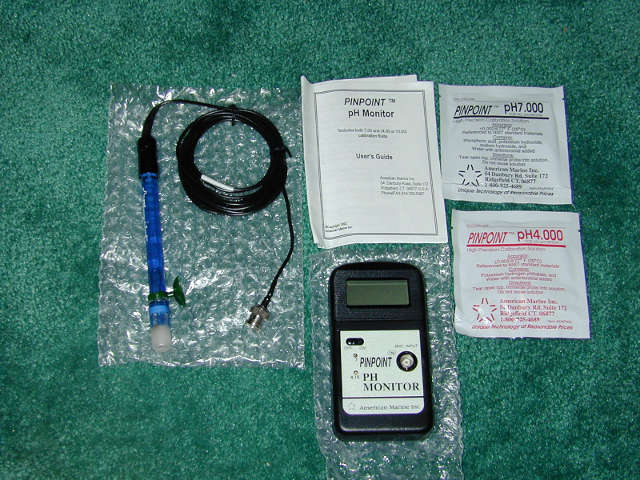
PinPoint pH Monitor
Pictured here in the PinPoint pH Meter made by American Marine. This is a small compact meter made for continuous monitoring of your tank's or calcium reactor effluent's pH. It included a brief instruction manual and 1 set of calibration fluids. I found that it wasn't as easy at it looks. The calibration solutions are not only temperature sensitive but are also sensitive to the CO2 levels in the air. Temperature is the biggest issue as usually you want the fluids to be at 25C and remain at that temperature for about 5 to 10 minutes while you calibrate the probe. (Check your calibration fluids to determine the correct temperature to use). Be careful when picking out calibration fluids, not all of them are accurate. They should be marked "traceable to NIST standards". I recommend you use single use packets which are in liquid form. They should also be stamped with an expiration date. NIST standard solutions come in pH values of 4, 7, 10 in the United States. European's typically use pH values of 5, 7, 9 (they always have to be different). If your main goal is to monitor your tank pH then use solutions of pH 7 and 10. If your primary goal is to measure your Calcium Reactor effluent then use pH 4 and 7 solutions. I use pH 4 and 7 because I mainly track the effluent of the K2R Calcium Reactor which is near pH 6.8. If you do use pH 10 solutions you must be 100% certain they are accurate. If the package has any kind of air leak or if you leave them open to long the pH value of the packet rapidly decreases. As an example Dr. Craig Bingman said he tested pH 10 calibration solutions found in pet shops and found some that were 9.5-9.6 -- these are totally useless. How I Calibrate My Probe: I suggest you get some warm water in a thermal mug say at 28C and place the sealed packets in the mug to come up to the right temperature. It should take about 5 to 10 minutes for the water to cool in the thermal mug which should be enough time for the calibration fluids to get to the correct temperature. Also have some fresh RO/DI water on hand to rinse the probe and some clean paper towels to dry off excessive water. Once the mug is at 25C I open the pH 7 solution and let the probe sit in the packet for about 4 minutes or until the reading is stable. Older probes take longer to get stable. Once you have a stable reading adjust the pH 7 screw until the display correctly shows 7.00. Rinse the probe in RO/DI water and dry off (do not dry the glass bulb tip). Then open the pH 10 solution and insert probe. Again wait for the display to be stable. Adjust readout via turning the pH4 or pH10 screw until your at the right reading (either pH 4 or pH 10). Clean and dry probe and place in pH 7 solution. Fine tune display as needed. It should take about 4 swaps before probe is right on. Place probe in fairly calm dark place on your tank such as the sump. You want to avoid air bubbles from contacting the tip of the probe as they will produce incorrect readings. Within a few minutes you should see your tank's pH value. I suggest you calibrate your probe every time you replace the battery which is likely around 3 months. |
